
Note: It has come to my attention via my network of loyal spies (they have a fleet of Lincoln Town Cars and Cadillac Broughams) that a certain aging, angry blogger likes to give the impression that I continue to write for his questionable, increasingly histrionic site by re-running stuff of mine that I wrote years ago. I do not. I have, in fact, had nothing to do with a certain website since the end of The Year Of Our Lord 2014. Yet he persists, probably due to laziness and apathy. So I believe I will be revising and posting some of those right here on Riverside Green. Let’s begin! -TK
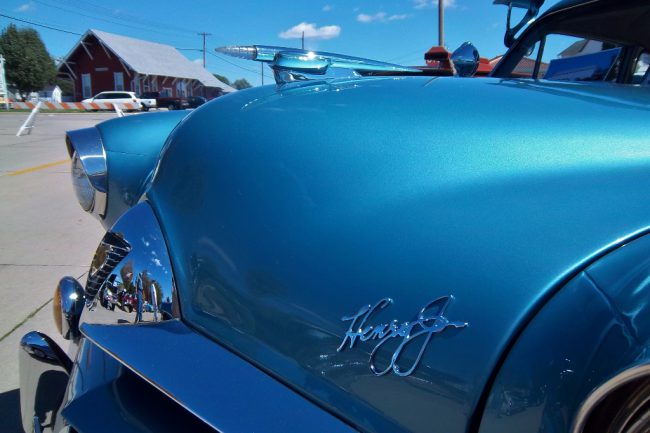
1951 was the year Kaiser-Frazer should have made it. A thoroughly restyled–and beautiful–Kaiser, a facelifted swan-song Frazer, and the all-new compact Henry J meant that Kaiser had spent ample time and money in rejuvenating their lineup. Never again would the company have such a modern and diverse lineup. Unfortunately, Henry Kaiser’s ego – “The Kaisers NEVER retrench!” – was a favorite saying of Mr. Kaiser’s, the lack of a V8 option when V8s were all the rage, and other myriad factors made 1951 the beginning of the end for K-F in the U.S.
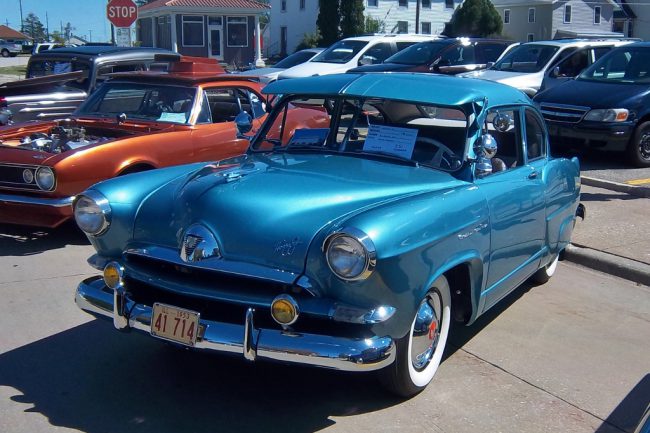
It seems to me that K-F had two big problems from the first: Pricing and lack of a V8 engine. Kaisers were too expensive when compared to the low-priced three triad of Chevrolet, Ford and Plymouth. At the same time, they were not really prestigious enough when shopped against an Oldsmobile 88 or Buick Super. Initially, exclusively six-cylinder power wasn’t a deal breaker. But once Cadillac and Oldsmobile’s compact V8s came on the scene for model year 1949, all bets were off for K-F’s success. So what did they do? Debut a V8 engine? Nope. They introduced a compact car.

One of the problems with the K-F experiment was Henry J. Kaiser’s ego. Perhaps his “my way or the highway” management style worked when his California shipyards were stamping out umpteen Liberty ships a day, but the car biz was a whole different story. So, instead of an updated full-size Kaiser, or perhaps much-needed V8 power, U.S. buyers got the Henry J. Arguably the most egotistically-named automobile in history.

Now, don’t get me wrong, I think the Henry J is a cool little car, even though it bombed in the marketplace. And I’m a fan of the big Kaisers too, especially the ’51-55 Dragons and Manhattans. But the campaign to name the new little K-F product always rubbed me the wrong way. A contest was announced, giving the public the opportunity to suggest a name. But after it was all said and done, Kaiser said “April fool!” and named the car after himself. Not cool, Henry.
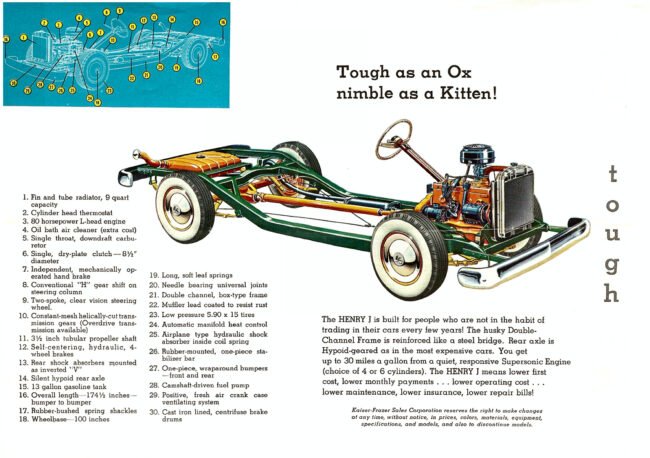
So what was a Henry J? It was part of the early ’50s compact car craze in the U.S. One by one they debuted–Hudson Jet, Aero-Willys, and the one bright spot in this new niche–the Nash Rambler. Only the Rambler would live to see its fifth birthday–and beyond.
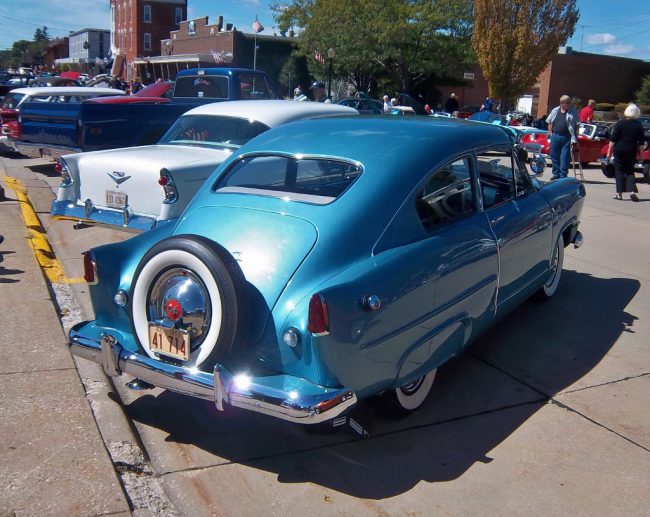
The Rambler did well because George Mason realized a cheap, bare-bones compact wasn’t going to fly with customers. Especially not when the independents’ smaller wares were about the same price–or more– than a full size Chevy or Ford. Thus, Ramblers were marketed as mini-luxury cars. And sold much better than the Jet, Aero-Willys…and the Henry J.
K-F took the opposite route, trying to sell on price. At their peril. The Henry J on introduction was a car only a true-blue skinflint could love: no glove box, no trunk lid (!) and an interior only slightly more deluxe than the cardboard box your Super Zenith console TV came in. Yes, if you needed the spare tire, you had to open the door and wrestle it out from behind the rear seat. Fun times! A radio and even turn signals were optional. And it was still expensive when compare to base Chevrolets, Fords and Plymouths.
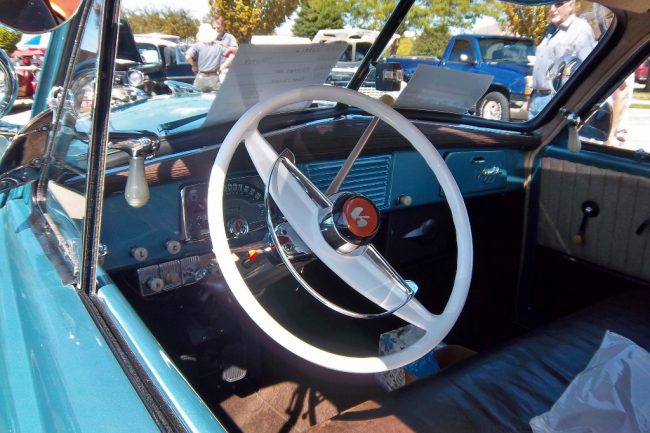
A ’51 model was $1363 with the four and $1499 with the flathead six, when a full size Chevy Styleline Special two-door sedan was $1403. The Henry J boasted modern styling, mini-Cadillac rear fins, and a 100″ wheelbase. The 68-hp four and 80-hp six-cylinder engines were supplied by Willys-Overland. Sales for ’51 were rather inauspicious, with 38,500 fours and 43,400 sixes built.

Would it get better? Not really. In Feb. 1952 the six-cylinder version returned as the Corsair, and received a new grille, grille molding, built-in parking lights, “Corsair” emblems on the front fenders, revised taillights and a slightly more plush interior. The four-cylinder model became a Corsair as well, but kept the cheaper interior of the previous Vagabond.

All the fussy little changes didn’t help. 1950 saw 30,947, 58,228 in ’51, 30,543 in 1952 and 7,459 in 1953 according to my Standard Catalog of American Cars 1945-1975. Those are calendar year sales, however. The supposed compact car “wave” never really crested, and the Henry J suffered right alongside the Hudson Jet and Willys Aero.
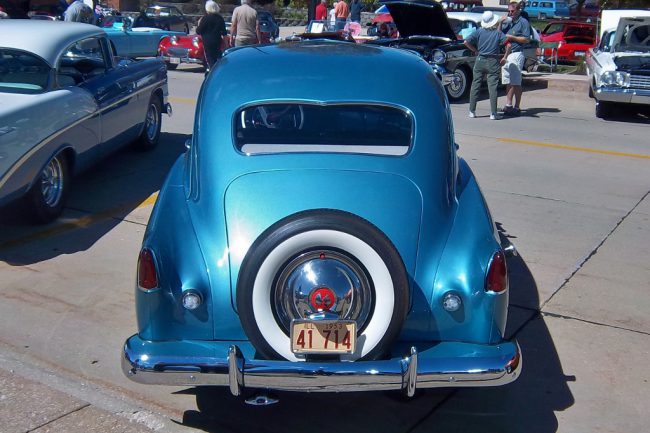
1953s received minor changes, most prominently a new rocket-shaped hood ornament, chrome wheel covers and a wraparound rear bumper. As in ’52, the four cylinder Corsair was plainer, while the six-powered Corsair de Luxe added chrome windshield trim, dome lights with door-mounted switches, an ash tray (fancy!) and nicer interior upholstery and door panels.

They look good today, and have one of the coolest hood ornaments I’ve ever seen, but in ’53, K-F dealers might have had trouble selling them even if they weren’t $100 more than a big Chevy on average. Inside, 1953 models added a padded dash and a “dustproof” instrument cluster.
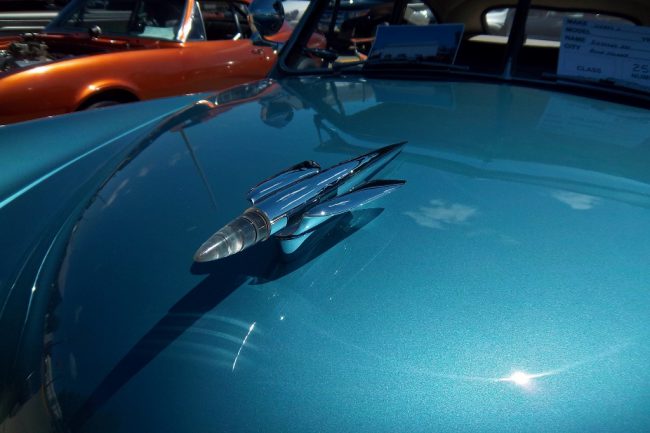
The year saw 8,172 de Luxes and 9,333 Corsairs built for the model year. As in the beginning, all Henry Js were built at K-F’s massive Willow Run factory. That same year, the Henry J won the Mobilgas Economy Run, but it didn’t matter. It was simply too little, too late. In fact, Kaiser-Frazer was just about ready to close down its automotive division in the U.S. and concentrate on Jeeps, as they had purchased Willys-Overland on April 28, 1953.
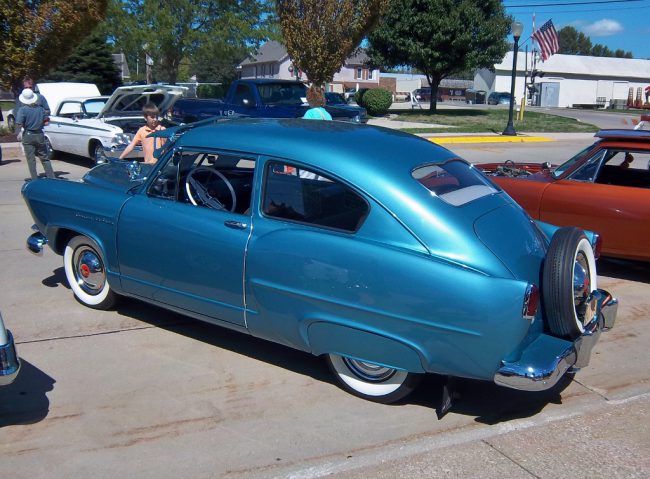
And with that, the Henry J’s short life was over, though the big Kaiser would survive all the way up to 1962 as the luxury Carabella sedan–but in Argentina, not the USA, which was abandoned after a short 1955 model year. Even the swan-song ’62 Carabellas were not significantly different from the US-market 1954-55 Manhattan.
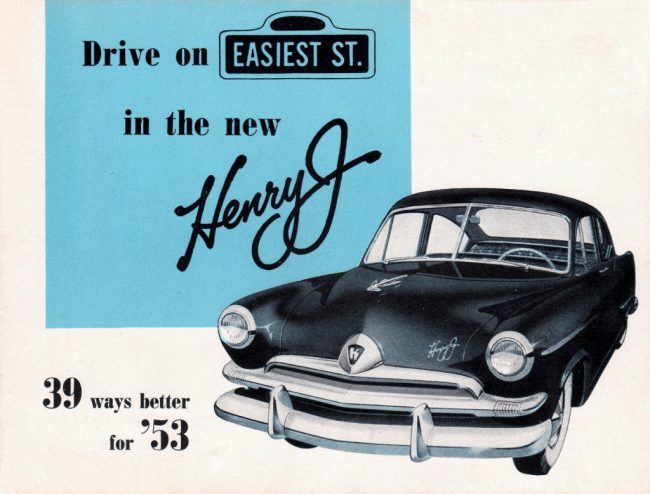
Henry Js are quite rare these days. First of all, not many were made in the first place. Secondly, they were popular as drag cars and ‘gassers’ in the late ’50s and Sixties. So I was very happy to see this beautiful sapphire-blue one at the Galesburg car show back in September of 2012. And with the exception of seeing one of those aforementioned hot rodded drag cars at a show at the Dairy Queen in Morrison, Illinois, I haven’t seen one since!







13 Comments
Tom, it’s quite unfortunate that you remain that bitter about CC. Being endlessly upset about things that happened on the internet is probably detrimental to your long term health, so I honestly hope that you can move forward on that..
Doug, I think most of us can understand the annoyance of seeing old pieces you weren’t paid for rerun in perpetuity on a site you stop producing for so long ago and eventually even banned from commenting on.
Yes but ;
TTAC still has some interesting articles, IMO they get far too much hate spew .
Mind you : I was banned for being honest, I can read and subscribe but not post there .
There are myriad web sites I don’t care for but I don’t waste time crying about nor attacking them like many here do .
I agree, it’s a pisser to see your old stuff re hashed but that’s life, : you sold it, they can do whatever they want with their properties .
Sort of like how magnaflow mufflers destroyed my old Chevy AD pickup ~ that was tough to see but my only complaint was : they lied to me and refused to honor the deal, cheating me out of many parts they didn’t want/need/use .
Oh, well .
-Nate
A couple things here :
#1, first and foremost, Chevy’s six cylinder engine was an antique in that time with poured non pressure lubricated rod bearings but it was an _overhead_valve_ design that gave far superior performance as less cost along with the basics, glove box , trunk lid, decent styling and so on .
K-F’s cars may have been Okay but they were funny looking and the new kid on the block . not a favorable mix .
Ypou also stated Chevy was big in 1953 and it certainly wasn’t any sort of big car, they were compact and cheaply built yet well appointed .
Remember : I’m a die hard Chevy Fanboi and general GM apologist but the facts remain ~ that one car at the car show looks nice but the average Henry J when new, was a cheap looking penalty box, no way ’round it .
-Nate
Nate, the Chevy 6 did okay. Toyota must have thought so, they used it in Land Cruisers until 2009, a seventy year run. Also did a lot to inspire the R series four that started in the 55 Crown and on and on through the small Toyota rear drives.
The OHV Chevy engine, introduced in the 1929 Model year did much more than ‘O.K.’ .
If they’d put the full pressure oiling GMC engine into the Chevy autos and light trucks in the late 1930’s they’d have set the world on it’s ear and dominated the market at the cost of the Sloan Ladder .
Toyota bought the rights to the 235 engine, a completely different engine than the one used in pre 1955 models, it too was a great design .
-Nate
Interesting that such a threadbare operation could manage the engineering challenge of offering a four and a six. Wish that skill could have been learned a little earlier by a long list or importers, even some that had no problem charging a premium like Audi and Honda.
The six was a Continental Engine Company product. In the pre-smog days, Continental did a bit of business with Kaiser and Checker and maybe a few other niche products.
The four, I’m not sure if it was a Continental or purchased from Willys, before Willys got bought up by the Kaiser conglomerate. But those engines were easy to obtain. A V8, not so much. It would have been like someone trying to buy Toyota’s Hybrid Drive layout for a competing car.
It make a car work with the bigger engine requires extra beef in the suspension and especially the drivetrain. Hyundai made some hay about how the current Sonata was simplified by the discontinuation of the six cylinder choice. Not offering the choice of engine where a choice is useful simplified many an import and a few domestic offerings, at a real cost to their customers. That Kaiser took the time and effort is commendable.
The Henry J six was not a Continental Engine it was a Willys engine. The big Kaisers used a Continental 226 CID six but the Henry J used either a Willys 134 CID four or a Willys 161 CID six. The four was under powered to say the least. I didn’t work well in a passenger car and was notorious for throwing rods.
If Henry J had been able to offer a Henry J with all the chrome and accessories of the photo car for the original price, they might have sold some, but the HJ’s that came out of Willow Run were mostly very, very, very spartan. The other element that hurt the early compacts was that the full-size Low-Price 3 were still reasonable sized cars (especially given the large family size of the time) not much larger than a modern Camry, and hence the fuel economy and parking ease advantages of the somewhat smaller HJ (or Rambler or Aero or Jet) were not very significant, while the purchase price was almost the same as you state.
Another of my favorite auto soap-opera sagas…that of Kaiser. Unlike Studebaker, I had the privilege of driving the last (model-year) Kaiser as a learner’s-permit holder. It was also, arguably, Peak Kaiser – even if it debuted as a Willys.
I’m referring, of course, to the Willys J-Series Jeep Wagoneer – rechristened its second year, the Kaiser-Jeep Wagoneer, and its body shell renamed SJ by its later owner, AMC. I learned to drive on a 1969.
Ah, but the car in question. Kaiser had no six, because Kaiser had no engine design facilities. Initially Kaiser had no engine line – buying Continental Engine Company flathead sixes. Later manufacturing them in-house under license. The later purchase of Willys-Overland, gave Kaiser access to a four; but there was no V8 to be had.
Belatedly, and on a shoestring budget, Henry J (the man, not the car) hired an experienced engineer, David Potter – to crash-design a V8. Meantime, money was running low…it was always low at Kaiser-Fraser but capital and credit were drying up) and the government do-gooders of the time wanted a small, “sensible” car in the market. I forget which government agency financed this, whether it was Commerce or Defense…but Kaiser put up a bid to produce a small, light, four-cylinder car with a low price…and have this agency loan him the money.
Clearly an early attempt at crony-corporatism, but then, Henry J got his start as a road builder; got his cred as a dam builder (Hoover Dam) and then burnished his halo as a Liberty-Ship builder. He knew how to do business with government.
Anyway. The car was duly designed; and to reduce weight, there wasn’t, initially, even a trunk lid. It was clearly a cheapskate special; and this was when Detroit was slaking built-up new-car demand from the war years, and was starting a price war.
And Kaiser couldn’t compete. Not without bleeding the parent company, Kaiser Industries. K-F had been cut off from larger revolving credit by Bank of America, their primary bankers; and the V8 was still not there. Nor was Henry going to budge from his idea of how to market cars – to build them in batches and store them until sold. Leading to all kinds of dealer and model-year chaos.
In the end, Henry’s ticket out was, again, government. Willys-Overland, provider of military vehicles, was again in bankruptcy. Henry didn’t understand the auto business but he sure had a sense for cost-plus government bidding. Kaiser-Fraser purchased W-O; rechristened the whole operation Willys Motors (changed to Kaiser-Jeep in 1963) and closed down his Willow Run plant.
The Continental flathead six became the basis for Willys-cum-K-J’s OHC six – once again, a brilliant concept but done on the cheap. Even the military didn’t want it, as they were quick to surp out their Kaiserm M715 trucks with Tornado Sixes.
And, David Potter. He was let go with the closure of K-F’s auto business and consolidation into Willys. He resurfaced at American Motors, where in record time (6 months, IIRC) he had a working prototype for the first AMC V8.
Which later was an option in Kaiser-Jeep J-Series wagons and pickups. Coming home, I guess, by a very roundabout way.
Again, a Henry J article containing erroneous information. It states that “For the 1952 model year the 4-cyl. was renamed Vagabond and the six was temporarily discontinued.” This is absolutely false. In fact, the production figures throughout the article are incorrect. In any case, the Henry J Vagabond came about because there were 7,000 left over 1951s (both 4 and 6 cylinder models) which had not been sold by the end of the 1951 model year. In order to get dealers to take this unsold cars, KF add a black hood ornament, and on most of them, a Continental spare tire and reserialed them at 1952 Vagabonds. Also, Kaiser did not “choose to make the Henry J” instead of developing a V8. The fact is Kaiser-Frazer was hurting big time in 1949 and needed a government loan to keep their operation going. The terms of that government loan was that part of it would go to produce a low-priced car that would sell for less than $1300. In order to stay in business, the had to build the Henry J – it was the only way to secure the government funding.